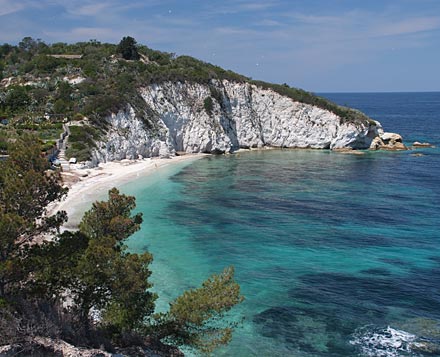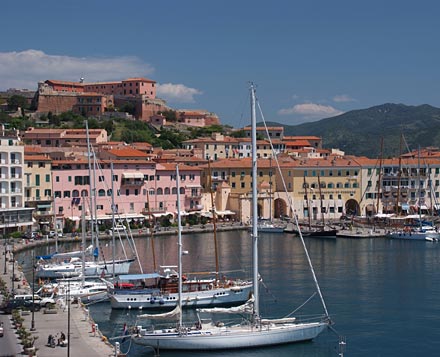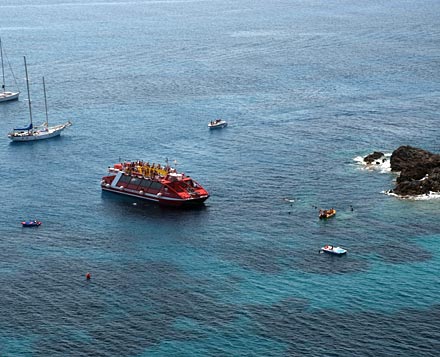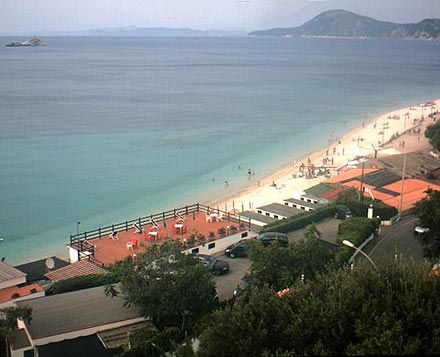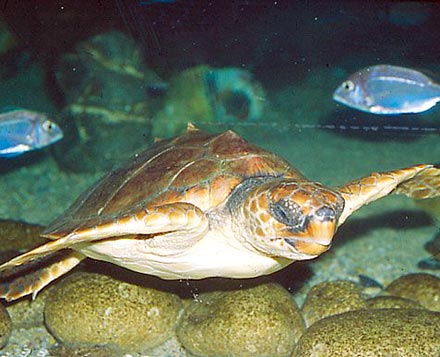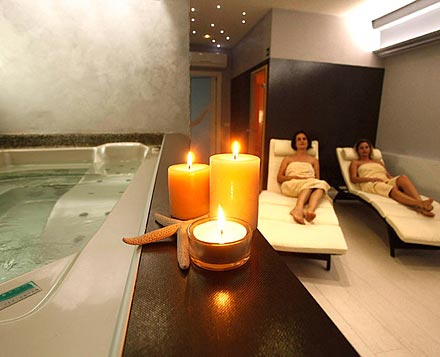Round Elba
THE ELBA AQUARIUM
The Elba Aquarium came to be in what used to be the Marina 2000 disco in Marina di Campo. Thanks to its size and above all because of the wide variety of species it is home to, it is without a doubt one of the largest aquariums in the Mediterranean.
Today 60 tanks with more than 150,000 liters of water can be seen in a fully covered area of approx. 1,000 m2, making the aquarium the second largest in Italy after the one in Genoa.
It is home to 150 different kinds of Mediterranean marine creatures, some of which are not only very rare, but not easy to find in captivity.
The most amazing attraction to be seen at the Elba Aquarium are the dolphinfish, large deep-sea fish, which as far as we know cannot be seen in any other aquarium. There is also a very high number of shellfish, and about 30 different species, and some of the mollusks, like the octopus or the newt, are very strange indeed.
MINERAL PARK
The mineral park on the Island of Elba serves the purpose of improving and adding ecological value to the areas that were run down as a result of mining. The idea was based on the need to give back to the environment a large area that had been exploited by humans and which, as a result, had changed dramatically. Today, the area relies on new concepts of cultural and educational value that the deserted mines now have to offer to the public.
With this park, the Park makes use of a lifesize model that covers everything that theoretical and specialized texts may not always explain clearly. The project includes the mining communes of Capoliveri, Rio Marina and Rio nell'Elba, and, with the mining museums, aims at giving true value to various cultural aspects from both an archaeological and a mineral point of view. There is also the opportunity to go on a tour, guided by members of the mineral park's qualified staff,
through the Rio Marina and Rio Albano open air mines, and to discover the underground magic found in the Ginevro tunnel in Capoliveri.
Our guests can also take part in the educational activities, such as searching for and examining minerals in the new Environmental Education Laboratory, an open air amphitheater with room for 700 visitors that offers a picturesque view of the sea as well as insight into the historic background of Elba's mines that can be found in the archives in the Palazzo del Burò.
The museum is spread over an area of 600 m2 inside the Palazzo del Burò in the old part of Rio Marina, and here you can find one of the most important collections of minerals on the Island of Elba with many examples of rare beauty.
In the museum, in addition to minerals you can also admire various different lifelike mining areas set up by industrial archaeological experts. The reproductions were built using original materials found in the antique workshops (a blacksmith's workshop, the miners' shelter and a small section of a tunnel, all true to the original size). Old tools and photos of the past complete this unique and impressive atmosphere.
The Alfeo Ricci Museum in Via Palestro, Capoliveri, is home to minerals from various parts of Elba, above all from the eastern side where the iron mines are. Visitors can see many examples of unique beauty, rarity and scientific value that make up the entire range of Elba's minerals. Alfeo Ricci, an extremely versatile man, spent all his time from the 1930s to the 1960s collecting and classifying minerals from all over Elba, especially from the eastern mining region. Today, his collection represents a living, scientific testimonial, and a passionate study of an paricularly rare mineralogical treasure.
A kind of natural continuation of the visits to the museum are the guided tours that vary in length and are done either on foot or on a small, picturesque train, but always planned and carried out by experienced environmental experts. They take you through the most important mining sites of Rio Marina, Rio Albano and Capoliveri, some of which were already being exploited during the Etruscan and Roman era, and you can be sure of experiencing an unforgettable excursion through magical colors, lunar landscapes, remains of train tracks and old processing sites. Not only, the tours through the antique mines enable you to experience first-hand the various aspects of the world of iron ore on the Island of Elba and the close relationship between man and minerals.
During the tour, the experienced guides give a detailed explanation of the different mineralogical forms and the mining techniques used over the years, and are ready and willing to answer any other questions you might have.
NAPOLEON BONAPARTE
The Island of Elba, not only throughout Italy, but also around the world, is famous for its beauty and its minerals found underground. But there is also another reason why the island is famous: the name Napoleon Bonaparte.
For Napoleon, Elba was a brief and yet in many aspects a golden exile, because not only did he stay here, he also governed from here, even if for just barely a year, from 1814 to 1815. He then fled and was defeated at Waterloo, after which he was banished to an even worse exile on the island of Sant'Elena in the middle of the Atlantic Ocean.
Napoleon arrived in Elba at the beginning of May in 1814. Prior to that, he had experienced the disastrous campaign in Russia and his defeat in Leipzig. Napoleon's legacy to the Island of Elba consists mainly of two museums that are housed in both of his residences: Villa dei Mulini (his city villa, in the old part of Portoferraio) and Villa San Martino (the larger of the two, in a natural environment, several kilometres from the island's major town in the direction of Procchio - Marina di Campo). A number of paintings and books can be found in the legacy Napoleon left to Elba.
On March 31st, 1814, the coalition of troops from England, Prussia, Russia and Austria invaded the city of Paris, and Napoleon had no choice but to sign his abdication. The Treaty of Fontainebleau signed April 11th gave him the right to be the prince of Elba and an annual pension of two million francs. In 1814, General Dalesme was the governor of the Island of Elba and the number of soldiers in his garrison was less than 500; the mine in Rio had been in disuse for months, because there was no way of transporting the iron from the site; very few men returned home from the Napoleonic wars; there was a great feeling of confusion and insecurity amongst the soldiers in the garrison after the defeat and abdication of Napoleon; all this gave birth to hostility towards the French.
Napoleon, who on May 3rd arrived at the roadstead on Elba on board the frigate "Undaunted" under the command of Captain Usher, wasn't really sure of what kind of welcome he would get. Before actually docking, he sent out a muster to the population holding a white flag with a red diagonal stripe that he himself had designed, inspired by the Grand Duke's merchant flag, with three golden bees added to it. Even the French cockade was replaced by a new one in different colours. The residents on Elba welcomed Napoleon enthusiastically, and the landing took place at the jetty opposite the Entrance to the port; Mayor Traditi handed Napoleon the keys to the city and then accompanied him, along with other authorities, to the abbey, where the vicar-general of the island, Monsignor Arrighi, celebrated the Te Deum.
After several days of eating and sleeping in the uncomfortable Biscotteria, the seat of the administration offices, Napoleon decided to turn some of the administrative buildings situated between the Fortresses Stella and Falcone into his personal residence, what we call today Villa dei Mulini.
The emperor was under the impression that he could stay on Elba forever, but once he was informed that the Congress that met in Vienna on November 1st had decided to banish him elsewhere, he decided to flee to France, trusting in and hoping for the assistance of the army that had remained true to him almost entirely.
Napoleon planned his escape in secret, because of the many spies that constantly kept a watch on him. On February 16th, 1815 he wrote to General Drouot: "Instruct my men to bring the brigantine to the inner harbor, and once there, it is to be turned on its keel and polished. All leaks are to be sealed and the keelhaul to be replaced and take any other necessary measures to assure that the ship is seaworthy. The brigantine is to be painted in the British colours. For all steps taken, prepare an estimate that you will present to me tomorrow. The brigantine is to be rigged and stocked with biscuits, rice, pulses and cheese. Half of the supplies to be stored on board are to be preserved in brandy and the other half in wine, as well as water for 120 men to last three weeks. As far as salted meat is concerned, we will take the amount required for 15 days with us on board. Make sure that there is enough wood and that nothing else is lacking. I want the brigantine to be in the roadstead between the 24th and the 25th of this month and to be prepared exactly as I have ordered."
And so, Napoleon secretly leaves the Island of Elba on February 26th, 1815 after having attended a Carnival ball at the Vigilanti Theatre. He himself had had the theatre, which still exists to this day, made out of the deconsecrated del Carmine church. Because surveillance by the British had been eased somewhat due to the absence of Colonel Campbell, who had left for Livorno, the brigantine Incostant, commanded by Captain Chautard, sets sail into the open sea with the Emperor on board. The ship was equipped with 18 canons. Under normal circumstances, the ship would have had a crew of 64 men, but under these conditions the crew was much smaller.
Two schooners and a French bombard were also part of the fleet. 400 infantrymen were embarked onto the "Incostant", another 200 onto the "Etoile", the horsemen onto the "Saint Esprit". 40 artillerymen, while 300 Corsican riflemen followed on other ships. One of the schooners served as a guard boat. The destination remained secret for security reasons. The ships headed westwards, setting sail independently so as not to look like a convoy. In fact, Campbell, who on the following day left the harbour of Livorno on board his frigate on his way back to Elba, suspected absolutely nothing.




